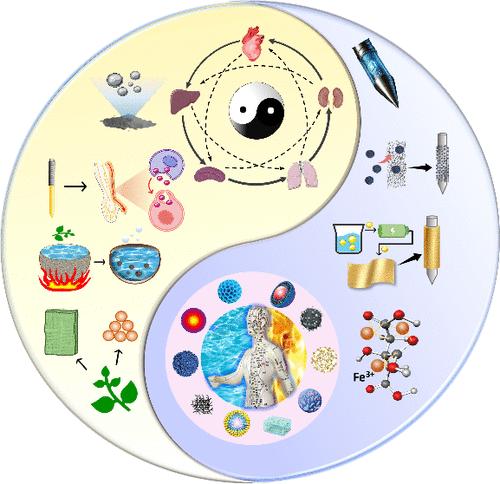近20年来纳米技术在中医针灸中的应用与发展综述
IF 8.2
2区 材料科学
Q1 MATERIALS SCIENCE, MULTIDISCIPLINARY
引用次数: 0
摘要
针灸,起源于传统中医(TCM),作为一种补充和替代的治疗方式,涉及将针插入身体的特定穴位,以刺激和治疗各种疾病。随着时间的推移,针灸已经获得了全球的认可,逐渐解决了越来越多的医学疾病。纳米技术的整合在提高药物递送效率和扩大针灸应用范围方面具有相当大的潜力,为研究经络和穴位的基本原理提供了新的机会。对过去二十年(2004-2024)纳米技术在针灸中的应用的文献计量学分析突出了该领域的新兴研究趋势和焦点。本文综述了纳米针灸的历史、生物学机制、制备方法和临床研究现状,重点分析了纳米针灸技术的应用。纳米技术使经络和穴位的可视化和成像成为可能,有助于深入了解针灸治疗效果背后的生理机制。结合纳米技术的改良针灸针具有双重功能:作为实时监测各种生理参数的传感器,从而支持疾病诊断和通过专门干预提高治疗效果。此外,纳米技术增强的针灸针可以作为靶向药物递送的平台,与反应性纳米粒子一起工作,用于疾病治疗。尽管纳米针灸有很大的潜力和临床应用,但它仍然面临着必须解决的固有限制和挑战。本文章由计算机程序翻译,如有差异,请以英文原文为准。

Application and Development of Nanotechnology in Traditional Chinese Acupuncture in Recent 20 Years: A Comprehensive Review
Acupuncture, rooted in Traditional Chinese Medicine (TCM), serves as a complementary and alternative therapeutic modality that involves the insertion of needles into specific body points to stimulate and treat a variety of conditions. Over time, acupuncture has garnered global acceptance, progressively addressing an increasing spectrum of medical disorders. The integration of nanotechnology holds considerable potential to improve drug delivery efficacy and broaden the scope of acupuncture’s applications, providing novel opportunities for investigating the underlying principles of meridians and acupoints. A bibliometric analysis of the application of nanotechnology in acupuncture over the past two decades (2004–2024) highlights emerging research trends and focal points in the field. This article provides an overview of the history, biological mechanisms, preparation methods, and clinical research status of nanoacupuncture, with a focus on analyzing the applications of nanoacupuncture technology. Nanotechnology enables the visualization and imaging of meridians and acupoints, facilitating a deeper understanding of the physiological mechanisms behind acupuncture’s therapeutic effects. Modified acupuncture needles incorporating nanotechnology can serve dual purposes: functioning as sensors for real-time monitoring of various physiological parameters, thereby supporting disease diagnosis and enhancing therapeutic efficacy through specialized interventions. Furthermore, nanotechnology-enhanced acupuncture needles can act as platforms for targeted drug delivery working in tandem with responsive nanoparticles for disease treatment. Despite its promising potential and clinical applicability, nanoacupuncture faces inherent limitations and challenges that must be addressed.
求助全文
通过发布文献求助,成功后即可免费获取论文全文。
去求助
来源期刊

ACS Applied Materials & Interfaces
工程技术-材料科学:综合
CiteScore
16.00
自引率
6.30%
发文量
4978
审稿时长
1.8 months
期刊介绍:
ACS Applied Materials & Interfaces is a leading interdisciplinary journal that brings together chemists, engineers, physicists, and biologists to explore the development and utilization of newly-discovered materials and interfacial processes for specific applications. Our journal has experienced remarkable growth since its establishment in 2009, both in terms of the number of articles published and the impact of the research showcased. We are proud to foster a truly global community, with the majority of published articles originating from outside the United States, reflecting the rapid growth of applied research worldwide.
 求助内容:
求助内容: 应助结果提醒方式:
应助结果提醒方式:


